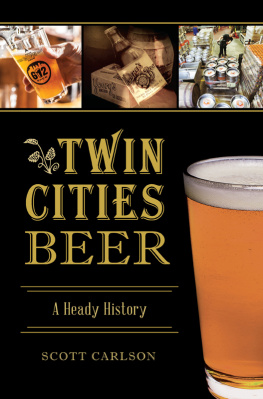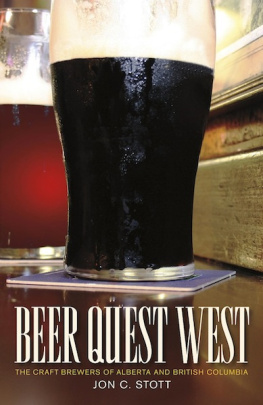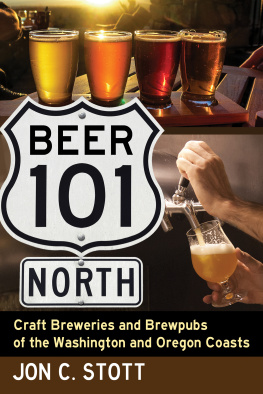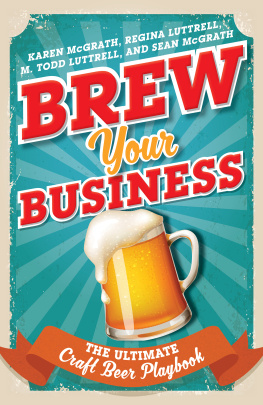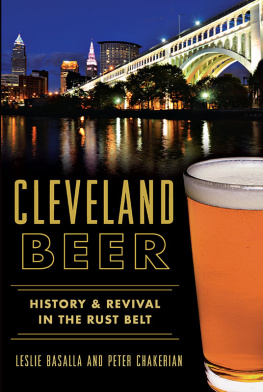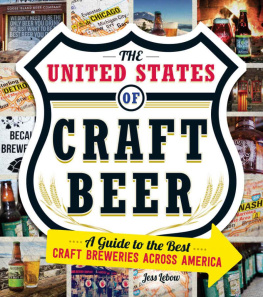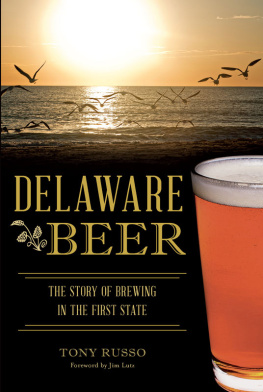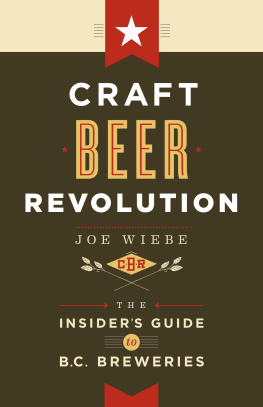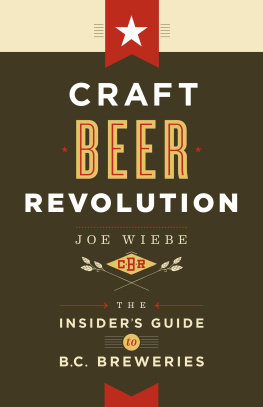Table of Contents
COPYRIGHT 2020 by Scott Messenger
All rights reserved. No part of this publication may be reproduced, stored in a retrieval system, or transmitted in any form or by any means, electronic, mechanical, photocopying, recording, or otherwise, without the prior written permission of the publisher. For more information, contact the publisher at: touchwoodeditions.com.
The information in this book is true and complete to the best of the authors knowledge. All recommendations are made without guarantee on the part of the author or the publisher.
Edited by Curtis Gillespie
Proofread by Alison Strobel
Cover design by Sydney Barnes
Interior design by Setareh Ashrafologhalai
Indexing by Janice Logan
LIBRARY AND ARCHIVES CANADA CATALOGUING IN PUBLICATION
Title: Tapping the West : how Albertas craft beer industry bubbled out of an economy gone flat / Scott Messenger. Names: Messenger, Scott, 1975- author.
Identifiers: Canadiana (ebook) 20190207272 | ISBN 9781771513210 (HTML)
Subjects: LCSH: Beer industryAlbertaHistory. | LCSH: BreweriesAlbertaHistory. | LCSH: MicrobreweriesAlberta.
Classification: LCC TP573.C3 M47 2020 | DDC 338.4 /766342097123dc23
TouchWood Editions gratefully acknowledges that the land on which we live and work is within the traditional territories of the Lkwungen (Esquimalt and Songhees), Malahat, Pacheedaht, Scianew, TSou-ke and WSNE (Pauquachin, Tsartlip, Tsawout, Tseycum) peoples.
We acknowledge the financial support of the Government of Canada through the Canada Book Fund, and the province of British Columbia through the Book Publishing Tax Credit.
For Carolyn and Garry, with gratitude and love
Introduction
A Journey into the Heart of Alberta Craft Beer
On a Friday afternoon, late in May of 2019, our car rolled to a stop on the Deerfoot into Calgary from Edmonton. A sense of dread pooled in my stomach. There was so much we needed to see, so many breweries to visit, and, because families with small children (such as mine) do not generally like the idea of one parent taking off for another city to drink beer, whether or not its for research, we had just one night to do it. I sat helplessly in the back seat, watching drivers around us jockey for what were essentially parking spots. Since hitting Calgary at rush hour was my fault, I said nothing of my concern to my friends. Guy was driving and Colin was beside him in the passenger seat.
Lets stop for lunch in Lacombe, I had said a few hours earlier, back when time seemed an abstract concept wed been measuring out in pints rather than centimetres of pavement travelled. Regret threatened to undermine what was supposed to be a momentous occasion: the beginning of our trip to a collection of breweries now the largest and densest in the Prairies. Scattered throughout neighbourhoods south of downtown Calgary are more than a dozen of them, serving up lager and ale judged to be among Albertas finest.
It was around noon that wed detoured from the hectic Queen Elizabeth II Highway for Lacombes charming, century-old downtown. In the middle of it, wed found Cilantro and Chive, a modern but rustic restaurant featuring a craft beer list few restaurants in Edmonton or Calgary can compete with. The salmon chowder was hearty even if in need of a dash of salt and a savoury something I could not quite put my finger on; the pint of dubbel, from Eighty-Eight Brewing, was a rich and malty promise of what we hoped to experience later that day in the Belt. But the meal had made us leisurely. After settling up, we asked Rieley Kay, the restaurants co-owner, where we should go in town for coffee. Sweet Capones, he told ustheir cannolis were outstanding. We ambled down the street past original brick facades (these had replaced wooden ones after a massive fire in 1906) and around the corner as instructed. Inside, I stared at a glass case containing a dozen varieties of the Italian pastry. What should I eat? I asked a smiling young woman with red hair pulled back in a severe ponytail. Salted caramel, she said, without hesitation. Though my friends chose to stick with coffee alone, I took the recommendation and indulged while they sipped. We did not hurry away. Only an idiot rushes through moments meant to be savoured.
Now, on the Deerfoot, I was ready to blame the cannolis. After loitering in the streets of Lacombe, we were stuck in a jam. I checked a map of breweries Id printed at home, looked at my watch, and juggled the order according to closing times and the minutes we were losing while immobile. A few moments later, as we crept less than a car-length ahead, I did it again, determined that this trip not be ruined. For the first time in my life as a fan of local craft beer, I had the opportunity to visit not just a single brewery but several in succession. Sure, there was no shortage of selection where wed come from. I was spoiled in Edmonton, home to Sherbrooke Liquor, the now legendary retailer with a beer cooler stuffed with more than six hundred Alberta beers. But this was different. This trip was less about the product and the deluge of choice, and more about the places and people behind itseeing what brewers have built and all the beer lovers who are drawn to it.
Or at least that was the plan.
A black pickup zipped into an empty space ahead of us and hammered the brakes. I checked my watch, and pictured breweries too full to make room for three weary travellers in search of a promised land. One more time, I ran through my list. Then, as if the universe could no longer bear my anxiety, it delivered us. Theres our exit, said Guy, glancing at an off-ramp jammed with vehicles. We still crept along, but an end was in sight and, with it, the prospect of a beginning. My mood brightened. Maybe the cannolis were worth it after all.
Later, once wed arrived and dumped our bags at our rundown but clean and comfortable hotel, we had a ride-share take us to the first stop on my revised itinerary: Village Brewery.
I had a perhaps outsized sense of excitement about our first stop, one that my friends, unfamiliar with the history of the place, and of beer in the province, didnt quite share. While they were eager for that first pint of fresh-made beer, I felt as if I were taking the first steps on a kind of pilgrims journey. Village was one of the last big breweries to open before everything changed in Alberta. Before the end of 2013, regulations were such that breweries had to be able to make at least 500,000 litres of beer a year. In my mind, the brewery was a kind of monument to the lengths to which people once went for craft beer, back before the provincial government decreed that small-batch commercial brewing was, well, no longer illegal. To my friends, it just seemed like a great place to grab a beer. They were right in thinking so, of course. But as we walked up the stairs to Villages taproom, it took all the restraint I could muster to keep from being the professor at the party and resist trying to impress upon my friends how important that day in 2013 really was, that it was a defining moment in Alberta craft beer as we know it today. Because, with it, what was then known as the Alberta Gaming and Liquor Commission (AGLC) and the Government of Alberta eliminated the industrys biggest barrier to entry, a seemingly arbitrary and decades-old law that had all but ensured that only the biggest spenders could afford to play. By 2014, anyone with the proper licence could brew as little or as much as they wanted to. The bar had not merely been lowered; it had effectively been tossed aside. All that the AGLC asked was that local products be fit and safe for human consumption. Having met the old requirement and started up in 2012, Village was among a small group of breweries, including Ribstone Creek in Edgerton, that marked the end of an era. In Calgary, this put it at the top of my list. I was just as eager for a beer as Colin and Guy, but not just any beer to start. I had an agenda.


